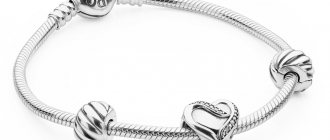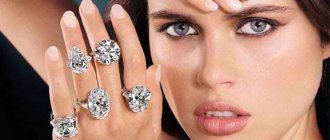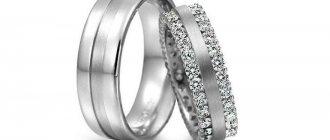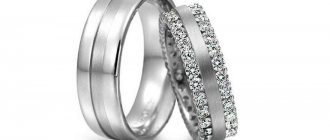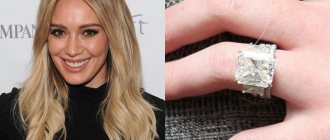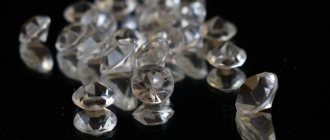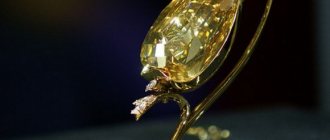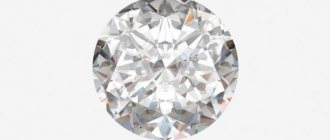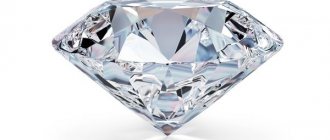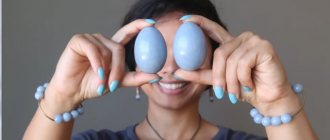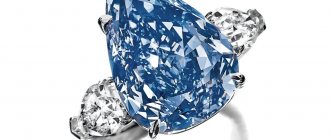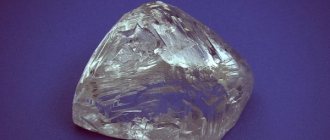Diamond and diamond - what's the difference? Some people believe that these are one and the same thing, while others consider them to be completely different stones. However, a diamond and a diamond do not fit into any of these opinions; they are interrelated, but not identical. Let's finally get to the bottom of this controversial issue.
These gemstones have been highly valued for centuries, and today continue to symbolize the wealth and glory of their wearers. The “King of Stones” is widely known as a jewel, but many people don’t even know what its brother, or rather its predecessor, is used for. Some people have heard about diamond coating, but nothing more. In this article, you will learn the differences between crystals, their prices, and the areas where each mineral is used.
Main characteristics
Diamond is the raw material for producing a polished diamond. Immediately after extraction, such a crystal has no jewelry value. It takes months of painstaking work to turn a plain mineral into a luxurious diamond. Cutting, grinding and polishing change the appearance and size of a diamond, but do not affect its physical properties.
General characteristics that a diamond and a diamond have:
- Hardness. For this property they have no equal among other natural materials. Translated from Greek, diamond means “indestructible.” To verify the strength of the mineral, you can conduct the following experiment: put it in the chamber of a hydraulic press. Gradual directed pressure will not crush the crystal. Nothing will happen to the diamond, but it will cause damage to the press - it will push through the steel base. The exceptional strength of the crystal is explained by its chemical structure - its atoms are packed very tightly.
- Fragility. They can withstand pressure, but are not able to withstand impacts. If you hit a diamond or diamond with a hammer, it will crumble, so it is impossible to make a knife or percussion tool from them.
- Weak conductivity of electric current.
- The highest thermal conductivity among minerals (4 times more than copper).
- Resistance to high and low temperatures. In open air they will burn at 850-1000 °C, in a stream of pure oxygen - at 720-800 °C. If you continue heating, the diamond will eventually turn into carbon dioxide and completely evaporate. As a result, not a trace will remain of the precious stone.
- Not destroyed by time (eternal).
At temperatures above 2000 °C, without access to air, diamond is transformed into graphite, a substance with opposite characteristics. Its hardness is lower than that of paper, and it conducts current very well.
Diamond
Kimberlite or diamond is a valuable mineral, a natural mineral, the progenitor of a diamond. Its structure is pure carbon. Such minerals are formed in the earth naturally - under the influence of high temperatures and pressure. They are found in special deposits. Mining these stones is a complex and time-consuming process, although sometimes they come to the surface.
In appearance, diamonds are nothing special. For those who do not understand minerals, this is an ordinary shapeless rough stone that does not have the characteristic “diamond” shine. It can have any configuration and dimensions. The largest natural black diamond (Sergio) weighs 3167 carats, which is 633.4 g.
Diamonds have a unique quality - high dispersion or play of the stone. When cut correctly, they sparkle and sparkle. One diamond after cutting can produce several diamonds.
Transparent and cloudy diamonds are found in deposits. The color depends on the impurities contained inside. In nature, yellow, pink, brown, green, and black diamonds are found. Blue ones are considered the rarest and most valuable.
Before placing a rough diamond in the hands of a jeweler, it is carefully examined by experts. They evaluate the quality of the stone using a special scale. Then the mineral is subjected to primary processing - peeling. Then it is sent for cutting, as a result of which it turns into a diamond.
The phenomenal properties of the stone were fully appreciated only in the 16th century, although people discovered it earlier (the first mentions of it date back to the third millennium BC). Since then, it has been used not only as a raw material for the production of diamonds, but also for industrial purposes.
Today, 97% of diamonds are grown artificially in chemical laboratories.
Diamond
A diamond is a cut diamond that, as a result of processing, has acquired a shape that reveals its color splendor and regal brilliance. It must have at least 17 edges.
The quality of such a gemstone is assessed according to four parameters (“4C of a diamond”):
- purity;
- carat weight;
- color;
- cut.
There is a popular belief that a natural diamond thrown into a glass of water will become invisible. There is even a legend that in the past, smugglers smuggled such stones across the border by hiding them in a bottle of water. Another myth also appeared: in the old days, jewelers stood at the window and compared its shade with water to determine the transparency of a diamond.
Practical experiments and theoretical calculations refuted the theory that this mineral can disappear in water. It will be visible regardless of cleanliness. The famous expression “pure diamond” comes from jewelers. This is how they speak about a stone that does not reflect in water - it does not contain inclusions.
With the development of laser technology, the concept of a “healed (ennobled) diamond” appeared. This is the name given to a stone from which inclusions have been removed by laser and the free space has been filled with glass material. After such manipulations, the mineral becomes less durable.
What is the difference between a diamond and a brilliant
Despite the same physical characteristics, a diamond and a diamond are not the same thing. The difference between them consists of the following factors:
- cutting;
- ability to reflect light;
- price;
- appearance – shape, shine, presence of inclusions.
What costs more
The price of a rough diamond is significantly lower than the cost of a polished diamond. A faceted crystal is much more expensive than its “progenitor”, even if it weighs less, because the processing process includes complex and labor-intensive technological operations.
The cost of a diamond is determined depending on the following characteristics:
- carat;
- color;
- purity;
- quality and complexity of cutting;
- current global prices;
- specific market conditions;
- allowances and discounts.
Raw minerals have long been in short supply. The market offers them in abundance, but it is not advisable to buy rough diamonds to save money. It is impossible to process such a mineral at home yourself.
To turn a diamond into a sparkling diamond, you will have to contact a jeweler who specializes in cutting such stones, has the experience and the appropriate equipment. His work is expensive, it will not give any savings. In addition, when buying a diamond, there is a great danger of running into scammers and purchasing a fake.
Types of cuts
Initially, diamond processing was not difficult. It included two operations. The stones were ground and polished. In 1465, the court jeweler of the Duke of Burgundy developed a round cut, which he called the “rose”. It is still the most common and inexpensive.
It was considered the standard until 1919, when Russian mathematician Marcel Tolkovsky, based on precise calculations, calculated the absolute proportions of the diamond’s facets. This is a classic cut. It includes 57 faces. They call her Russian. When light hits the stone, it refracts along the edges and creates a rainbow effect.
In 1961, Arpad Negy increased the number of facets to 65. His cutting method was called "Princess". It is considered ideal due to the clear symmetry of the edges.
Today, up to 200 options for cutting gemstones are used.
The most common types:
- round;
- fantasy - heart, marquise, briolette, asscher, emerald, baguette, oval, antique and others.
Purchasing Tips
When purchasing jewelry with a crystal, you should follow certain recommendations:
- You should look at the gem in a certain light, only then can you see the purity and color of the gem. Jewelry stores should have fluorescent lighting.
- It is advisable to ask for a certificate at a jewelry store; it is required for all diamonds. It is prepared by a special gemological laboratory. The report provides information on the most important characteristics and properties of the gemstone. The document is a crystal passport so that it cannot be confused with other stones.
- When purchasing diamond jewelry, be sure to check its characteristics. Between two seemingly identical stones, the price can vary significantly. This is due to differences in purity and color.
- When purchasing diamond jewelry, you need to look not only at clarity, cut, weight and shade, but also at the treatment. When a gem has excellent shade and transparency, but has strong fluorescence and poor quality proportions, its value is significantly reduced.
- It is necessary to give preference to a gem with weak or zero fluorescence; you should not purchase jewelry with a high degree.
- You need to purchase a stone with a high-quality cut. When it is assessed as inferior, it is advisable not to purchase the product.
What else is the difference between a diamond and a diamond?
The main difference between a natural or synthetic diamond and a diamond is that the second one has been processed and sparkled with all its polished edges. A natural uncut crystal is not able to reflect light, and therefore does not produce the effect of radiance.
In addition to external characteristics, there are other differences between a diamond and a rough diamond:
- Weight.
- Areas of use.
- Diamonds can be found in jewelry stores. Diamonds in their pure form are almost never presented anywhere. The exception is specimens of unusually large sizes that cannot be processed (they will fall apart). Such giants are exhibited in museums.
Mass of mineral
The initial weight of a diamond is much higher than the weight of the diamond into which the jeweler will turn it. The master will comprehensively examine the crystal, select the appropriate type of cut, apply markings, and then mercilessly remove everything unnecessary. To reveal the beauty and brilliance of a natural mineral, most of the precious material has to be turned into worthless dust.
The difference in weight between a diamond and the resulting diamond can be colossal. During processing, the diamond loses a lot of weight. After all the transformations, it turns out to be an expensive diamond of several carats or less.
Carat
The weight of a diamond is usually measured in carats. One carat is equal to 200 mg or 0.2 g. This is a fixed value: 1/50th of a gram is 1 carat. This unit of measurement is used only for precious stones. Technical ones are measured in grams.
It is difficult to determine by eye the carat value of a stone inlaid into a product, because you cannot put it on a scale.
This can only be done by a specialist who has been working with similar minerals for a long time.
You can find out the weight of a round-cut diamond by its diameter:
- 0.1 ct = 3 mm;
- 0.3 ct = 4.3 mm;
- 0.5 ct = 5.15 mm;
- 1 ct = 6.5 mm;
- 1.5 ct = 7.4 mm;
- 2 ct = 8.8 mm;
- 3 ct = 9.4 mm.
Diamonds of the following sizes are used for inlaying jewelry made of precious metals:
- Crumb – up to 0.01 carat. Their size is less than 1 mm, so they do not give an iridescent shine, but only flicker when hit by light.
- Small – 0.01-0.29 carats.
- Medium (most in demand) - 0.3-0.99 carats. Stones of this size shimmer with a brilliant shine, and the product has a relatively affordable price.
- Large – from 1 carat and above. A diamond is an expensive stone. A ring or other piece of jewelry with a massive diamond of this size is affordable only for wealthy people.
The number of its facets also depends on the weight of the diamond:
- less than 0.03 carats – 17 facets;
- 0.03-0.5 carats – 33;
- from 1 carat and above – 57;
- the largest specimen has 102 edges. This type of cut is called majestic.
The size of a 1 carat stone can vary greatly in appearance. It all depends on the cut.
What influences the cut of diamonds? Popular forms
Whatever epithets are used in reviews of specific jewelry, the utilitarian task of cutting is only one - to change the angle of refraction of the sun's rays on the surface of the stone so as to create the most brilliant play of light, shimmering with all the colors of the rainbow.
Today, the most popular diamond cut shapes are:
- Circle;
- Oval;
- Baguette;
- Square;
- Marquis;
- Princess;
- Pear;
- Heart;
- Cushion.
There are other styles that have been patented by famous jewelry houses. For example, Tiffany True diamonds are considered the world standard for engagement rings, and the coded form KR-57, which has proven itself for small stones, is generally designated as “Russian Cut” in international catalogs. The process itself has long been automated as much as possible, but special shapes with non-standard symmetry or edges are always processed manually.
Areas of application
Diamonds extracted from the quarry are cleaned and sorted. High-quality specimens are sent to jewelers for processing. Stones with cracks, scratches, chips, foreign inclusions and dark-colored diamonds are used for technical purposes:
- In medicine - for the manufacture of surgical instruments.
- In instrument making - to make lenses for photosensitive equipment.
- In the metalworking and construction industries , for the manufacture of heavy-duty tools for boring and milling hard materials. Diamond chips are used to cover the working surfaces of cutting discs and abrasive equipment. Diamond-coated tools are used for cutting, countersinking, drilling, grinding and polishing. They are used to sharpen knives, teeth, and cutters. They speed up the processing of hard and brittle (glass, ceramics) materials by 50%.
- In the manufacture of ships, cars, electrical appliances.
Tools coated with diamond powder are also used in everyday life. These are glass cutters, files, needle files, diamond hand stones. They simplify and speed up construction, repair and business operations.
Diamonds are used for decorative purposes only:
- They are inserted into jewelry - rings, earrings, necklaces and others.
- Today, clothes decorated with a scattering of diamonds have become fashionable.
- Diamonds of rare color of the highest category A are used to make tiaras and other jewelry for royalty.
- Outstanding specimens are kept in museums so that a large number of people can admire their beauty.
Every diamond was a diamond in the past, but not every diamond mined or synthesized will turn into a diamond. These minerals are “blood relatives,” but they are not identical. When entering a jewelry store, do not ask the consultant to show you a ring with a diamond, and in a hardware store do not ask to sell you a file with diamond chips.
